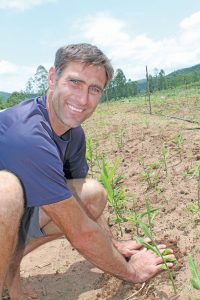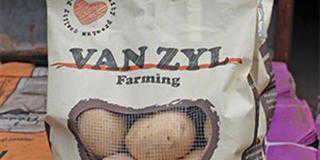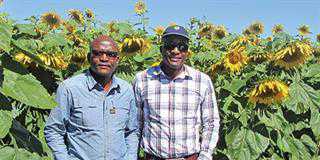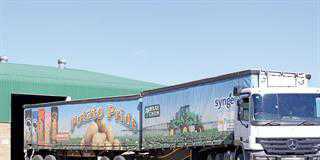
Photo: Lindi Botha
South Africa’s booming macadamia industry has presented an interesting opportunity for growers of the crop to cultivate ginger.
Since both crops demand the same climate, and macadamia trees take five years before they are in production, the rows between the trees offer an ideal space during this period to plant ginger.
This is what led Jaco Lubbe near Kiepersol, Mpumalanga, to take up growing a crop that he well knew was difficult. His father, Japie, was one of the first ginger producers in South Africa and first planted the crop some 20 years ago, but then gave up cultivating it.
“Ginger is a very intensive operation, so it takes up a lot of time. My father felt that the other crops on the farm needed more attention, so he stopped planting it,” says Lubbe.

“About five years ago, we decided to start growing ginger again because we needed the cash flow while waiting for our macadamias to come into production. Initially, we planted it between the macadamias as we had unused space between the rows, and the macadamias could also benefit from the nutrients we feed the ginger.
“Ginger has a high nutrient requirement, so we’re constantly supplying nutrients through the micro-irrigation system. The macadamias utilise some of these as well.”
Sabie Valley Ginger is a family business, and in addition to Japie, Lubbe’s brothers Jurgens and Japie Jr form part of the enterprise. They cultivate macadamias, ginger, turmeric and galangal on the farm.
Land and labour
The family currently plants 15ha to ginger and are increasing this area annually due to high demand for the crop, and the relatively low local supply. Ginger is an annual crop but requires constant attention, according to Lubbe.
“It’s highly labour-intensive and most of the processes are manual. We need around seven workers per hectare for harvesting, washing and packing.
“The other limiting factor is that the rotation time between one crop and the next on the same piece of land is four to seven years. Eventually, you run out of land on your farm to plant ginger, necessitating the hiring of land elsewhere if you wish to continue.”
He adds that the reason for the long rotation is to reduce the build-up of pathogens and pests in the soil.
Creating the ideal microclimate
Although the subtropical climate in the Kiepersol area is favourable for ginger, additional irrigation is needed to create a suitable microclimate for optimal production.
“Ideally, you want a tropical or subtropical climate where the minimum and maximum temperatures don’t vary drastically,” says Lubbe.
“High humidity is also a requirement. We get about 800mm of rain a year, but still need a huge amount of water to create a microclimate to keep the plants cool if the air temperature exceeds 32°C. This means we need to micro-irrigate at a rate of up to one million litres a day on hot days.
“The sprayers are positioned approximately 1,5m from the ground. The water doesn’t necessarily penetrate the soil, but prevents the leaves from burning. Few farmers have access to this amount of water, which is why ginger production is not widespread in South Africa.”
Managing the water is a challenge, admits Lubbe; the roots must not be drenched in water as this leads to phytophthora and a build-up of fungi and bacteria.
In addition, ginger requires soil with a high humus content as this contains the right nutrients. The darker the soil, the better; sandy soils, for example, are not suitable as they leach more rapidly and tend to exacerbate the nematode problem that often arises with ginger.
Healthy roots
Because a portion of the harvested ginger roots are replanted to produce the next crop, the farmer needs to select the best for this purpose. The challenge, according to Lubbe, is to cultivate pathogen-free seed.
“Planting infected seed can contaminate the whole land and can lose you your entire crop. We follow strict hygiene practices to keep the seed storage areas clean, and clean all implements used in one land before moving to the next.
“But keeping everything pathogen-free is very difficult, because even the water is contaminated. We can’t sterilise the water, because when we kill the harmful bacteria, we kill the beneficial bacteria as well. Every bug that’s killed has consequences. Therefore we
need to make sure our plants are in the best condition possible so they can fight the pathogens. The soil needs to be healthy and contain sufficient nutrients to feed the ginger.
“It’s also important to ensure balanced fertiliser applications, as fertiliser can be detrimental to soil bacteria. Nitrates are sodium-based and kill many soil organisms. We’re still trying to find the winning recipe between boosting the beneficial organisms, feeding the soil and eliminating pests and harmful bacteria.”
Nematodes, armyworm and phytophthora are the main pest threats.
“Anything that causes a lesion in the plant is a problem because this creates an entry point for harmful bacteria. Good general management can go a long way towards keeping pests at bay,” Lubbe says.
Production cycle
Sabie Valley Ginger’s production starts around June with soil preparation. A soil analysis is carried out to determine the nutrients that are needed for the new crop.
Lime and cattle manure are applied, as ginger has a high requirement for lime, and manure adds organic matter to the soil. The lime is added at a rate of about 2,5t/ha and the manure at 5t/ ha. The latter is first tested to ensure that it contains no pathogens that can infect the soil.
“This is the only opportunity we have to add organic material to help improve soil health and create a humus-rich profile,” explains Lubbe. “We add inorganic substances such as nitrogen and potassium throughout the season.”
The soil is then ripped to loosen it thoroughly before planting.
“You don’t want to limit the growth of the ginger by having compact soil,” he says.
Planting takes place at the end of August to ensure that the plants have grown sufficiently to cope with the extreme heat, rain and insect infestations of summer.
Lubbe and his team start by making furrows in the soil and adding organic matter, such as vermi-compost or manure, into them. They then place the ginger pieces on top of the compost about a hand’s length apart and cover them with soil.
As the plants grow month by month, the workers heap soil around the plant to create a soft ridge into which the ginger grows. This ensures that the soil temperature around the ginger stays high enough to encourage growth.
As weeds and grasses grow much faster than the ginger, constant weeding is required.
“We don’t do chemical control. The workers physically pull out all the weeds, adding to the labour-intensiveness of the crop. Some farmers spray the lands with glyphosate before the new ginger emerges, but we believe it sets the crop back.”
Fertigation is applied as needed, with each growth phase of the plants requiring a different programme.
“Initially, we need to boost the foliar growth, and after that the root. The crop needs constant feeding.
“We try to spray as little pesticide as possible; interfering produces its own problems! We focus on scouting rather than following a set pesticide programme. We first send in a team to kill the worms by hand, and only if this is ineffective do we spray,” says Lubbe.
The ginger is harvested from May onwards. Because it can remain in the ground for several months, the Lubbes are able to harvest the crop continually and send produce to market. The current average yield is 50t/ ha, but they are aiming at 65t/ha.
Harvesting is done manually with pitchforks, and every effort is made to lift the ginger out of the soil without breaking it.
“It’s a daily process to train the staff to do this as carefully as possible. We need to get the biggest pieces possible as they fetch higher prices. The small pieces are sold as second-grade produce,” Lubbe explains.
The roots are then washed with high-pressure hoses and placed in crates to be sent to the packhouse, where they are cleaned more thoroughly. Excess mud is removed, small roots are cut off and the ginger is brushed. It is then packed into boxes and sent to market.
The ginger is harvested in the morning, and by the evening has already reached fresh produce markets around the country.
Consistent supply
Lubbe believes that South Africa has a winning recipe in the country’s fresh produce markets.
“We get a fair price and we don’t have to go around looking for a buyer.”
However, he notes that prices can fluctuate, especially when large quantities of ginger are imported.
“The only way to get around the huge price fluctuations is to deliver a consistent supply throughout the year so that the market doesn’t need to rely so heavily on imports. Because ginger is a cash crop, few farmers focus on consistent supply, which then creates a need for imports.”
He maintains that there is still much room for expansion in the market, as ginger is not a highly consumed crop in South Africa.
“This is also due to a lack of knowledge on how to use fresh ginger, so people need to be educated on how to use it. But there’s an increasing awareness of the health benefits of ginger. Consumption will grow, and we’re expanding production on the farm to meet that need.”
Despite the many challenges and high costs involved with ginger farming, Lubbe enjoys growing the crop.
“I love being a ginger farmer. It’s wonderful to plant a crop that has a positive effect on people’s health. I also enjoy working with the soil, and ginger is a crop where your hands need to be in the soil, because nothing is mechanised.”
He adds that profits can be good if production is carried out properly. And there’s the added benefit that being labour-intensive, the crop is a good job creator.
“Success lies in having a good product and delivering consistently, not simply planting when the price is high and stopping when the price drops.”
Email Jaco Lubbe at [email protected].













